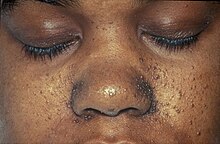User:Mr. Ibrahem/Tuberous sclerosis
| Tuberous sclerosis | |
|---|---|
| Other names | Tuberous sclerosis complex (TSC);[1] Bourneville Pringle syndrome[2] |
 | |
| A case of tuberous sclerosis showing facial angiofibromas in the characteristic butterfly pattern | |
| Pronunciation |
|
| Specialty | Neurology, medical genetics |
| Symptoms | Seizures, intellectual disability, developmental delay, behavioral problems, autism[4] |
| Complications | Kidney and lung problems[4] |
| Duration | Life-long[4] |
| Causes | Genetic disorder (autosomal dominant)[4] |
| Diagnostic method | Based on symptoms, supported by medical imaging[4] |
| Differential diagnosis | Focal cortical dysplasia[5] |
| Treatment | Physical therapy, occupational therapy, speech therapy, behavioral therapy, antiepileptic medication[4] |
| Prognosis | Variable[4] |
| Frequency | 1 in 6,000[4] |
Tuberous sclerosis (TS) is a genetic disorder that results in the growth of non-cancerous tumours in the brain and other organs such as the heart, eyes, lungs, and skin.[4] Common symptoms include seizures, intellectual disability, developmental delay, behavioral problems, and autism.[4] Onset of problems is often in the first year of life; though may occur later.[4] Complications may include kidney and lung problems.[4]
It is caused by a mutation of either the TSC1 or TSC2 gene, which code for the protein hamartin and tuberin, respectively.[4] While it may be inherited from a person's parents in an autosomal dominant manner, most cases occur as new mutations during early development.[4] These proteins are believed to be tumor growth suppressors.[4] Diagnosis is generally based on symptoms and supported by medical imaging.[4] It may also be confirmed by genetic testing.[6]
There is no cure, with treatment being supportive in nature.[4] Efforts may include physical therapy, occupational therapy, speech therapy, and behavioral therapy.[4] Antiepileptic medication, such as vigabatrin, may be used for seizures.[4] Long-term outcomes are variable and depends on the severity of the symptoms.[4]
Tuberous sclerosis may affect up to 2 million people worldwide.[2] In the United States it affects about 1 in 6,000 children; while it is a somewhat less common in Europe.[4][2] Males and females are affected with similar frequency.[2] It was first described by French neurologist Désiré-Magloire Bourneville in 1880.[7] The name refers to the irregular swellings in the brains, that maybe shaped like potatoes.[4]
References
[edit]- ^ "Orphanet: Tuberous sclerosis complex". www.orpha.net. Archived from the original on 8 May 2024. Retrieved 9 May 2024.
- ^ a b c d "Tuberous Sclerosis - Symptoms, Causes, Treatment | NORD". rarediseases.org. Archived from the original on 7 June 2023. Retrieved 9 September 2023.
- ^ "Tuberous sclerosis - Symptoms and causes". Mayo Clinic. Archived from the original on 9 September 2023. Retrieved 9 September 2023.
- ^ a b c d e f g h i j k l m n o p q r s t u v "Tuberous Sclerosis Complex". National Institute of Neurological Disorders and Stroke. Archived from the original on 1 June 2023. Retrieved 9 September 2023.
- ^ "TUBEROUS SCLEROSIS". www.epilepsydiagnosis.org. Archived from the original on 21 October 2021. Retrieved 9 September 2023.
- ^ "TUBEROUS SCLEROSIS". www.epilepsydiagnosis.org. Archived from the original on 3 August 2023. Retrieved 9 September 2023.
- ^ Brigo F, Lattanzi S, Trinka E, Nardone R, Bragazzi NL, Ruggieri M, et al. (December 2018). "First descriptions of tuberous sclerosis by Désiré-Magloire Bourneville (1840-1909)". Neuropathology. 38 (6): 577–582. doi:10.1111/neup.12515. PMID 30215888. S2CID 52269610.
